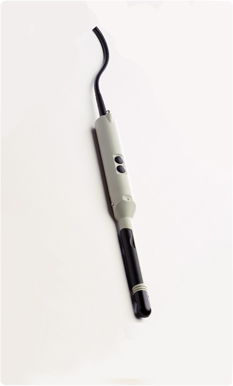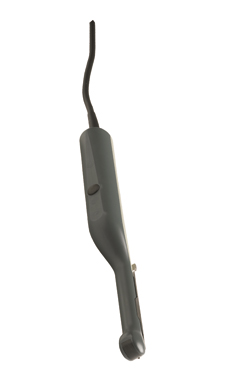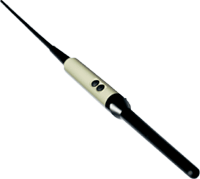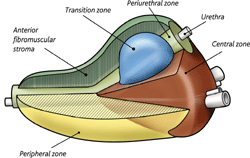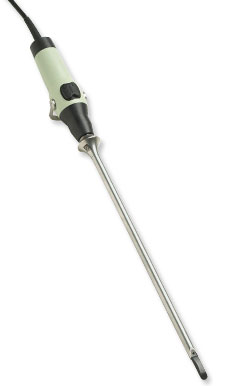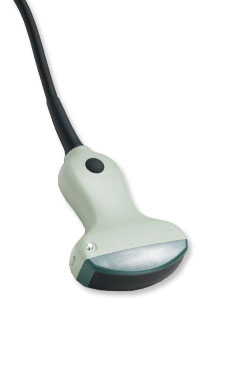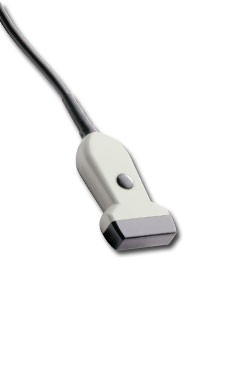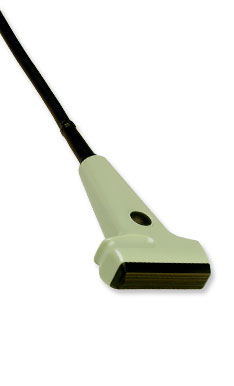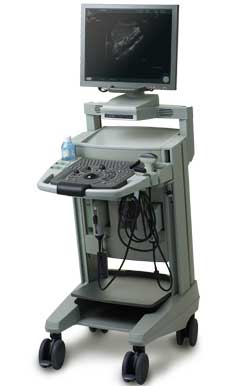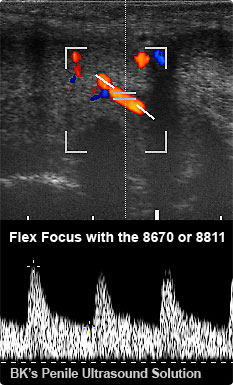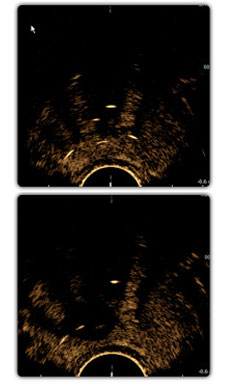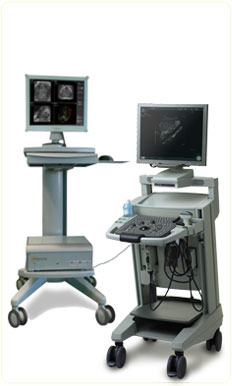|
| |
Ultrasound Transducers
For general transducer application
information please go to TRANSDUCER
INFORMATION
|
|
 |
Triplane – all prostate zones with one
transducer
- unsurpassed images in
3 visionary planes
- switch between
prostate zones at the touch of a button
- increase diagnostic
value with 3D, Contrast and Doppler
Easy and comfortable to use
- take confident apical
biopsies with endfire array
- biopsy the
peripheral, transition and central zones with
simultaneous biplane
- one-time insertion
and minimal manipulation using disposable dual guide
Read more about our sterile single-use
needle guides
here.
8818 Applications
- Transrectal prostate
scanning
- Transrectal puncture
and biopsy
- Transperineal
puncture and biopsy
- Transvaginal scanning
- Spectral and CFM
Doppler examinations
- Tissue harmonic
imaging
- Contrast imaging*
|
 |
|
|
|
 |
Simultaneous biplane: the gold
standard
- for orientation and
correct biopsy spacing
- real-time images of
both the sagittal and transverse planes
- confidently take core
biopsies
Multifrequency simultaneous biplane
probe
- high frequency for
excellent near field scanning
- excellent power
doppler
3D and harmonic imaging for easier
identification of lesions
- use 3D as a
diagnostic tool
- visualization of
lesions in 3 planes appears to allow improved
assessment of capsular disruption
Dedicated biopsy guides
- easy cleaning and
contamination prevention
- the needle path is
angled optimally through the channel bracket instead
of running along the shaft of the transducer
Read more about our sterile single-use
needle guides
here.
|
 |
|
8808
Specifications |
|
Frequency range |
6 - 10 MHz |
|
Contact surface (acoustic) |
5 x 19.6 mm |
|
Scanning Modes |
B, M, Doppler, BCFM, Tissue
Harmonic |
|
Focal range |
5 - 50 mm |
|
Sector Angle |
biplane / 127° |
|
Disinfection |
Immersion, STERIS SYSTEM 1® |
|
Dimensions |
120 x 21 mm |
|
Weight |
|
|
|
 |
Endfire prostate imaging
- wide endfire image
plane enables you to locate a lesion and then rotate
the plane around a central axis.
A balance between resolution and
penetration
- multifrequency
capability enables reduction of frequency to 6 Mhz
without removing the transducer
Convenient puncture
- the needle's path
starts at the tip of the probe
- monitor the needle
from the start of the puncture to the actual biopsy
site
8667 Applications
- Endorectal scanning
- Interventional
procedures
- Spectral, CFM and
Power Doppler examinations
- Tissue harmonic
imaging
|
 |
|
8667
Specifications |
 |
|
Frequency range |
6 - 10 MHz |
|
Contact surface (acoustic) |
50 mm2 |
|
Focal range |
5 - 50 mm |
|
Scanning modes |
B, M, BCFM, Doppler, Tissue
Harmonic, Power Doppler |
|
Disinfection |
Immersion, STERIS SYSTEM 1® |
|
Dimensions |
300 x 36 mm |
|
Weight |
260 g |
|
|
|
 |
Image guided prostate therapy
- No gland too
large — sagittal scanning of any size
prostate from base to apex
- Resolute,
clear and detailed image, for accurate
volume studies and source dose planning
- Customizable
sagittal grids and preferences for
brachytherapy
- Clear
visualization of seminal vesicles
- Clear view of
needle placement
Pelvic Floor Scanning
- Best broad
view of anterior and posterior compartments
for functional and anatomical studies
- Reproducible
3D studies with external mover
- Detailed
high-resolution biplane with 6.5 cm. linear
and convex views
* In the USA, contrast-enhanced
ultrasound has not been market cleared by
the FDA, with the exception of only select
cardiac imaging applications.
|
 |
|
|
|
|
 |
Unique biplane imaging: Two planes are
better than one
- biplanar with
multifrequence capabilities
- long sagittal array
for base to apex view in seed implantation
procedures
- easier prostate
volume determination
Colour Doppler and transperineal
facilities
- excellent for all
transperineal procedures including brachytherapy
- transperineal needle
guide
8658 Applications
- Prostate
brachytherapy
- Transrectal scanning
- Transperineal
puncture
- Transvaginal scanning
- Intraoperative
scanning
- Cryosurgery
- Spectral and CFM
Doppler examinations
|
 |
|
|
|
 |
Easy access to kidney diagnostics
- superior image
quality
- minimizes patient
discomfort
Exceptional image quality
- clearly view
structures using deep penetration at higher
frequencies obtaining a high image resolution with
coded excitation
- measure renal blood
flow with superb spectral Doppler
- visualize anatomic
variations and residual tumor after RF and
cryoablation with contrast imaging
- find kidney stones
easily with harmonic imaging
Ideal for interventional procedures
- single-use and
reusable needle guides for convenient interventional
procedures
8823 Applications
- Kidney
- Bladder
- Pediatric
- Difficult to access
areas
|
 |
|
8823
Specifications |
|
Frequency range |
1.8 - 6 MHz |
|
Contact surface |
31 x 12 mm |
|
Penetration depth |
26 cm |
Scanning modes
B, M, Doppler, BCFM, Contrast,
Tissue Harmonic |
Disinfection
Immersion, sterile covers,STERIS
SYSTEM 1®, single-use and
reusable puncture guides. |
|
Dimensions |
94 x 44 mm |
|
Weight |
150 g |
 |
|
* In the USA, contrast-enhanced ultrasound has
not been market cleared by the FDA, with the
exception of only select cardiac imaging
applications. |
|
|
|
 |
The most advanced laparoscopic
ultrasound transducer on the market
- built in facilities
for LUS-guided biopsies
- RFA
- ethanol or contrast
agent injections
- cryoablation
- microwave ablation
- flexible for
difficult to reach areas or
- rigid for
manipulating structures
8666-RF Applications
- Laparoscopic
- Intraoperative
- Radiofrequency tumor
ablation (RFA)
- Biopsy
- Drainage
* In the USA, contrast-enhanced ultrasound has not been
market cleared by the FDA, with the exception of only
select cardiac imaging applications.
|
 |
|
8666-RF
Specifications |
|
Frequency range |
5 - 10 MHz |
|
Focal range (typical) |
5 - 95 mm |
|
Contact surface |
30 x 5 mm |
|
Sector angle |
36° |
|
Scanning modes |
B, M, Doppler, BCFM,
Tissue Harmonic Imaging
and Contrast Imaging* |
|
Disinfection |
Immersion, EO (ethylene oxide),
STERIS SYSTEM 1® or STERRAD® |
|
Dimensions |
302 x 178 mm |
|
Weight |
475 g |
|
|
|
 |
Deep penetration and high resolution
- clearly visualize
deep anatomical structures
- coded excitation
Comfortable ergonomic design
- a control button
right on the handle
- slim design and
rounded handle enables lighter grip with minimum
pressure
More diagnostic information
8820e Applications
- Liver
- Pancreas
- Bladder
- General abdominal
- Obstetric scanning
- Interventional
procedures
|
 |
|
8820e
Specifications |
|
Frequency range |
2 -6 MHz |
|
Contact surface (acoustic) |
62.5 x 13 mm |
|
Scanning modes |
B, M, Doppler, BCFM, Tissue
Harmonic, and Contrast* |
|
Focal range |
12 - 200 mm |
|
Disinfection |
Immersion |
|
Dimensions |
104 x 77 mm |
|
Weight |
180 g |
* In the USA, contrast-enhanced ultrasound has not been
market cleared by the FDA, with the exception of only
select cardiac imaging applications.
|
|
|
 |
Quality, versatility and convenience
in one transducer
Small part, musculoskeletal and
vascular scanning. The 8670 supports a number of
ultrasound applications, such as small part, breast and
orthopedics, rheumatology and sports medicine.
- Easy switching
between near and far views
- Very high image
detail
- Excellent choice for
penile Doppler and testis
- Optimized for small
part, musculoskeletal and vascular scanning
- Easy-to-use puncture
and biopsy guide
- Small part
- Breast
- Testis
- Penile Doppler
- Musculoskeletal
- Peripheral vascular
- Interventional
procedures
- Contrast Imaging
|
 |
|
8670
specifications |
|
Frequency range |
5 - 12 MHz |
|
Contact surface |
45 x 14 mm |
|
Focal range |
0 - 70 mm |
|
Scanning modes |
B, M, BCFM, Doppler, Tissue
Harmonic |
|
Disinfection |
Immersion |
|
Dimensions |
91 x 52 x 21 mm |
|
Weight |
130 g |
* In the USA, contrast-enhanced ultrasound has not been
market cleared by the FDA, with the exception of only
select cardiac imaging applications.
|
|
|
 |
A clear choice for cost-effective
imaging
- very high frequencies
- large footprint
- Doppler sensitivity
- True Echo Harmonics
Puncture guides for convenient biopsy
Puncture guides available have:
- 30, 45 and 60 angles
of insertion.
- variable diameter,
allowing you to choose the desired needle size.
Disposable needle guides and sterile
transducer covers are also available.
Immediate lesion assessment
- provides image
clarity and contrast resolution
- determine necessity
for biopsy on the spot
- perform aspiration or
biopsy immediately
|
 |
|
8811
Specifications |
|
Frequency range |
5 - 12 MHz |
|
Focal range (typical) |
2 - 55 mm |
|
Acoustic contact |
50 x 4 mm |
|
Disinfection |
Immersion
or STERIS SYSTEM 1 |
|
Dimensions |
105 x 64 x 22 mm |
|
Weight |
98 g |
|
|
|
 |
Kidney anatomy
Imaging the kidneys can be a challenge
because of their depth. The kidneys are hidden behind
dense muscles and the shadow of the ribs. Our
transducers compensate for anatomic constraints and
produce clear images with deep penetration during
intercostal scanning.
Urologic ultrasound of the kidney
Ultrasonography for renal diagnostics is
inexpensive, safe, and fast. Renal ultrasound provides
information about the location, shape, size, and outer
shell thickness of the kidney. Ultrasound is a tool to
screen for kidney stones, cysts, and masses. Detailed
information from a scan can be used to accurately choose
the best course of therapy.
The Pro Focus UltraView, 8823 or 8820e,
and laparoscopic 8666 provide a complete renal scanning
package.
|
|
|
 |
Testicular ultrasound
With our ultrasound equipment it is
possible to:
• Examine a suspicious mass
• Monitor infection or inflammation
• Evaluate injuries
• Identify testicular torsion
• Check for vascularity
Varicoceles
The presence of varicoceles is a leading
factor in the cause of male infertility. Varicoceles can
be reliably diagnosed using ultrasound.
Testicular torsion detection
Learn more below about how Colour Doppler
ultrasound can be used for a quick and effective
examination and diagnosis.
Testicular ultrasound tools
The 8670 and the
Flex Focus are a great
choice for Doppler and testis scanning.
|
|
|
 |
Penile Ultrasound
The 8811 and the 8670 transducers are
great choices for Doppler and Penile scanning.
Erectile Dysfunction
Using spectral Doppler it is possible to
examine and quantify blood flow. To perform the
examination, a vasoactive substance (e.g. prostaglandin)
is injected to produce an erection, and if successful,
the problem can most likely be corrected. A comparison
of arterial velocity before and during erection can many
times provide an explanation to the cause of erectile
dysfunction.
|
|
|
 |
Doppler Ultrasound
A noninvasive diagnostic tool
used to evaluate vascularity.
Doppler solutions
The UltraView and the 8818,8808e, 8667,
8823, 8670, 8811, 8848, 8658, or 8820e
Learn more about the benefits of Doppler
for
|
|
|
 |
The largest portfolio of Contrast
solutions
With an UltraView solution you have
all the tools necessary to locate and map lesions,
evaluate blood flow, biopsy suspicious areas, and
follow-up after therapy. The UltraView together with our
surgical, abdominal, small part, and endorectal
transducers, are ideal for Contrast enhanced imaging.
Kidney & Prostate
See Contrast Solutions below for Contrast enhanced imaging of the
kidney and prostate.
Urologic Contrast Solutions
UltraView
and 8818,
8848,
8823,
8666,
or 8820e.
* Contrast Enhanced Ultrasound (CEUS) has not been
market cleared by the FDA for use in the USA. Consult
your local authorities for CEUS market clearance
information in your country.
|
3D solutions
UltraView
or
Flex Focus scanner.
Transducer 8808,
8818,
8848,
or 8658
.
A magnetic wheel mover with professional 3D software,
or freehand.
|
 |
3D
Ultrasound Imaging Solutions
3D ultrasonography is available on a
wide range of BK transducers as a standard option, and
several of our urology transducers offer tracked 3D
imaging capabilities.
How 3D imaging works
The advantages and benefits of 3D
imaging.
The role of 3D in prostate
diagnostics.
|
|
|
 |
HistoScanning™ compatible products for the prostate
HistoScanning™ is an
affordable, non-invasive diagnostic imaging tool for
prostate diagnostics and is offered only on BK
solutions. This exciting, revolutionary technology
promises to change the way specialists perform prostate
diagnosis and biopsies. HistoScanning™ may help
physicians make more informed treatment decisions for
their patients.
To get started, you will need the
licensed HistoScanning-ready UltraView scanner and to
license the HistoScanning workstation from AMD. The
system is compatible with the
8818 or
8848 transducer
and requires a magnetic wheel mover for accurate
motorised sagittal and/or transverse 3D prostate
scanning.
HistoScanning is CE marked. HistoScanning
has not been market cleared by the FDA for sale in the
USA.
|
|

